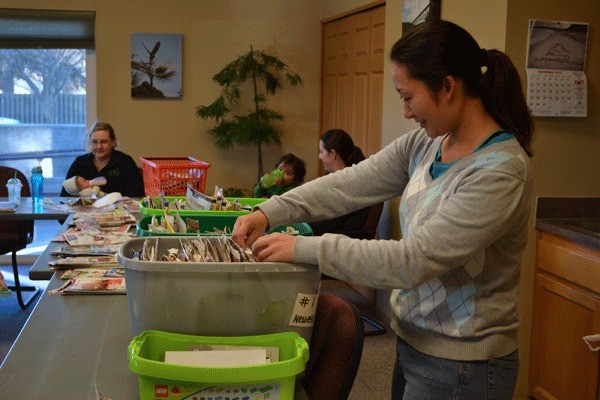Adults gathered around long tables with coupon books — clipping, passing and chatting away as rugrats played with Duplos and other toys in the center of the tables.
“We have C-O-O-K-I-E-S for the kids,” Amy Hannold spelled out for the parents, so she wouldn’t cause a sugar riot amongst the children.
For the past three years, this has been Hannold’s favorite part of the week. She is the North Whidbey Coupon Club coordinator, and every Friday morning devoted couponers congregate to clip and confer about their week.
“It’s the quilting bee for people that want to save money,” Hannold said.
Hannold works with Ula Lewis, Good Cheer volunteer coupon coordinator in Langley. Together they run the Whidbey Coupon Club.
Lewis started couponing when she was a kid and carried the practice into adulthood when she was raising 11 kids.
“They had everything they needed and mostly everything they wanted,” Lewis said.
Most of her kids are couponers and Lewis uses her skill at Good Cheer.
“Coupons are cash,” Lewis said.
“These are currency.”
For every dollar she spends for Good Cheer, she is able to put $5 worth of food on the shelves.
“I have a hard time paying $1.79 for a can of tomatoes that I would’ve paid 30 cents for,” Lewis said.
Lewis also brings items she’s purchased with coupons for Good Cheer, so people can buy products while they’re there.
The items also visually illustrate her point and she sells them for what she paid. At the Friday meeting, she brought a dozen eggs she bought for 49 cents and snack-size Nabisco cookies for 65 cents.
When people arrive, Hannold has four bins set-up of coupons filed by date. She also provides a good deal alert list, which Lewis writes, tips to get organized, meal planning and a coupon shopping list. She also provides scissors and paper clips for attendees to use.
“We’ve grown 30 percent in the past eight weeks,” Hannold said. “It’s a lot more effort for these bins to stay full.”
Boxes are being set-up around town to collect unwanted inserts. Oak Harbor Chamber of Commerce, Oak Harbor Senior Center Whidbey Island Bank and the Oak Harbor Christian Reform church are collecting inserts, but more drop-offs are needed.
“If they’re going to end up in the recycling bin, they can do a lot more mileage here,” Hannold said.
Even if coupons have expired, the club still collects them. The commissaries overseas accept coupons that are six months past the expiration date, so they are sent to families that can use them, Hannold said.
Many different types of people attend the coupon club. From young parents to empty nesters, the club has someone from almost every demographic. And they help each other.
“I’m watching skills get passed around the room,” Hannold said.
Renee Fangman, Oak Harbor resident, is one of the experts who offers her assistance to others. Her mother taught her about couponing when she was young, but she didn’t start until two and half years ago.
Part of the reason Fangman coupons is so she can stay at home with her kids.
“It would be a lot tighter if I didn’t coupon,” Fangman said.
When starting out, Fangman focused on Walgreens and CVS. She would collect coupons for non-food items, such as toiletries and cleaning supplies.
“Food coupons are scarce compered to toiletries, laundry detergent and things like that,” Fangman said. “It’s a lot of information if you’re starting out, so start with one store and branch out.”
As she built a routine, she was able to expand into other areas.
Fangman uses a binder and clear baseball card sheets to store her coupons. That way she can flip through and see what deals she can maximize on in the store.
“I use coupons on sales to stretch my dollar more,” Fangman said.
For example, one store had macaroni and cheese on sale for two for $1. She had a coupon for that specific product which gave her $1 when purchasing two items. Therefore, she was able to get her macaroni and cheese for free.
When she shops, other shoppers sometimes give her looks because of her coupon binder.
“They think ‘Oh she’s a couponer,’ but I’ll strut it,” Fangman said.
Fangman has coupons mailed to her from a friend in Nevada and she buys four Saturday Whidbey News-Times a week.
She buys the newspapers at Starbucks and uses a gift card — one that she’s earned from other point-based system offers — to purchase the papers. Then after earning stars through Starbuck’s reward program, she can have a free drink.
With the assistance of the Internet, couponing has become easier, Lewis said.
Between websites, blogs and social media, it’s easier to find out great deals fast.
“A lot of places do the work for you,” Fangman said.
Fangman started using apps on her phone to help find more deals. She uses Shopkick, Viggle, Ibotta and CheckPoints.
To be successful with coupons, one must have realistic expectations, Hannold said. The work needs to reflect what the person is willing to put into it.
After the show “Extreme Couponing” came out, a lot of people expected Hannold to teach them how to make huge purchases with coupons.
That’s not a realistic expectation, Hannold said.
“Everyone coupons differently and for different things,” Hannold said.



